
|
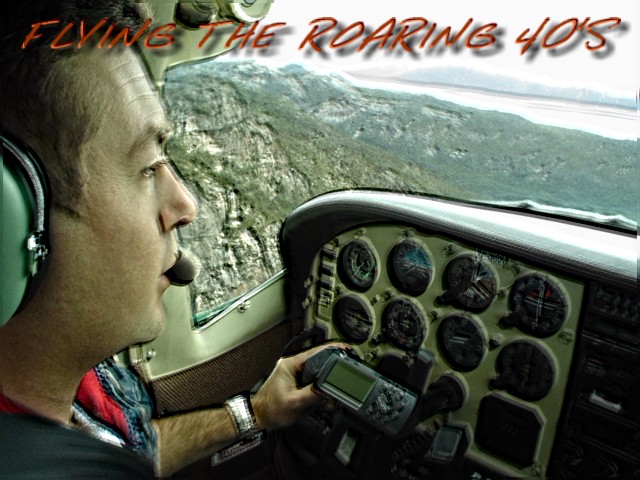
ADAM GOES ISLAND HOPPING IN THE LATITUDES OF 40 DEGREES SOUTH.
The remote and rugged Furneaux group of islands situated in the Bass Straight is where Adam takes up island hopping.
I was in between flying jobs after just completing the season scaring birds off the almond crops in the riverland of S.A., when I was offered two months relief work flying the mail to Flinders Island in Bass Strait. After breif discussions with my very patient girlfriend Kendall, it didn't take me too long before I had my bags packed and was catching the next plane to Tassie. I landed in Tasmania on a cold ,crisp Autumn night.A good mate of mine, Garry Dukes, was flying choppers on forestry operations out of Scottsdale at the time, he was good enough to make the 120 km round trip to the Launceston airport to pick me up.The following morning he would drive me to Bridport to pick up the 'mail plane' to Flinders Island. The cold thick air smelling distinctly of wood smoke filled my nostrils as we drove through Launceston on the way to Scottsdale that night. Just the winding drive through Targa gap that night gave me a gut feeling that I was going to love Tassie. The following morning we left before dawn for the Bridport airstrip. After breif introductions with Warwick, the Cheif Pilot, he loaded the aircraft to the roof with the usual newspapers, mail and freight. We donned our life jackets ready for the 35 minute Bass Strait crossing to Flinders Island. An awe inspiring flight followed, between the tall granite peaks of Cape Barren Island and over the numerous small islands in Franklin Sound the only problem was that Warwick, now 15 miles from our destination, pointed out to me that a large fog band looked to be drifitng right over the Lady Barron airstrip! "Great" he said, "this might get interesting", we drew closer and after an overfly of where the airstrip should be he determined that only about half of the 450m strip was covered in fog and that a landing to the west down the hill and over the single wire powerline could be made and we would be firmly planted on the ground before entering the fog at the other end of the strip. Hmmm... I thought to myself, I reckon there's going to be some pretty challenging flying to enjoy around here!

The workhorses were the Cessna 206 & 207 before the GA8 Airvan Arrived.
Safely on terra firma after some expert flying by the Cheif Pilot, we were met by 'Hughie', the owner of the business.Well, he was just the typical silver haired, wiry bearded bush pilot character that you have visions of. I had met the man who was good enough to say over the phone only a week or so prior "yeah you seem to have plenty of 206 time, I don't normally hire pilots over the phone, but I'll give you a run.." He grabbed my bags and said "right I'll give you a look around where you'll be for the rest of ya life!..." I thought to myself, "You've gotta be kidding, this bloke's got some plans for me, I somehow think the 2 months he told me was a joke just to get me here!" Anyway as it has turned out, the 2 months has been slightly stretched out a bit....talking with a lot of the locals you soon find out there must be something special about this place because a lot of them only came here for a 2 week holiday, 25 years ago!! Anyway, I'm still here, followed very shortly after by my very patient girlfriend Kendall (who now happens to run the office for the company) flying the wilds of Tassie and Bass Strait. Battling the Roaring 40's trade winds, the ever changing weather, in and out of short and rough island strips and best of all enjoying a nice wood fire at nights..who'd want to be an airline pilot when you can have this much fun!!
|
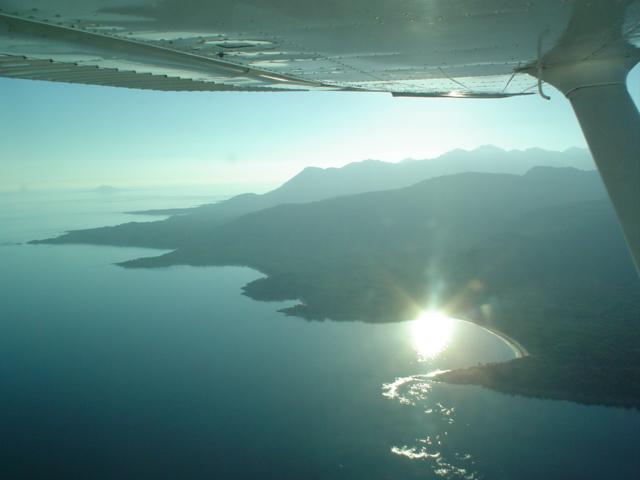
A view of Mt Strezleki from Franklin Sound
|
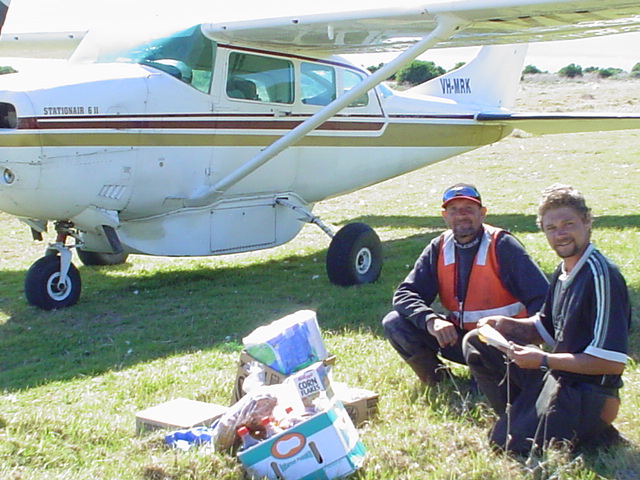
Island locals and their cargo before a flight to an outer island.
Across latitude 40 degrees south in Bass Strait lies the remote and rugged Furneaux group of islands, Flinders Island being the largest of 52. This group of isolated islands is battered by the Roaring 40's trade winds that blew our early sailors around the bottom of Africa, across the Southern Ocean towards Australia. Flinders Island is only a fairly small mass of land being roughly 100km long by 35km wide,however, there is some of the best scenery Tassie has to offer crammed into this little island. The main industries here are fishing and farming livestock. As I have found out, you would never starve on this island, the seafood and game is plentiful namely crayfish, abalone, scalefish, ducks, quail, bush turkeys,wallabies and my personal favourite Tasmanian muttonbirds.
There are 133 pristine, white sandy beaches with clear blue turquoise waters around Flinders Island. Kendall and I found out that during the warmer months (December thru March) when beach going, if someone was at the beach of your choice it is no problem to just drive a little further around and have your own private beach all to yourself! The warmer currents of water tend to flow down the east coast of Australia during this time which raises the water temperature to around 18.C ideal for diving, swimming and snorkelling for a feed of crayfish or abalone.
The relentless Roaring 40's wind has, over millions of years, shaped this maritime landscape of granite rocks and trees leaning to an easterly direction. This place is truly a pristine environment of mountains, beaches, lagoons and feilds of golden tussocks which lends itself to being some of the most spectacular and pleasurable flying areas, providing the weather is good!
Beacause of it's latitude and maritime position, flying the islands of Bass Strait can also prove to be very challenging. As Hughie used to tell me "some days are just better than others", meanwhile I'd be looking out the window thinking to myself "I'd rather be sitting in front of the fire right now..." Conditions can rapidly change from seafogs to thunderstorms and wild winds which makes it pretty interesting on final approach into some of our short and hilly island strips. Because of the treacherous sea conditions light aircraft tend to do most of the work around the islands. We fly anything and everything from live animals to cartons of eggs. There are dozens of airstrips on outlying islands close to Flinders, they tend to be short, rough and sloping with the odd one way strip that require a good deal of bush airmanship to negotiate safely.The company I fly for was formerly Sinclair Air Charter, recently taken over by Gordon Rorison trading now as Flinders Island Aviation Services. We are based in Bridport on the north east coast of Tassie and Lady Barron on Flinders Island. We operate a Cessna 206 (my personal favourite) a 207 and recently acquired a brand new Australian built GA 8 Airvan which is proving itself well in this environment. Our core business is to provide a daily mail and freight service to and from mainland Tassie, Cape Barren Island, Clarke Island, Chappell Island and Swan Island. Other flying consists of general passenger charter, medivacs and the odd search and rescue. We are a very flexible outfit being ready to go anywhere and cart anything at any time during the day
|
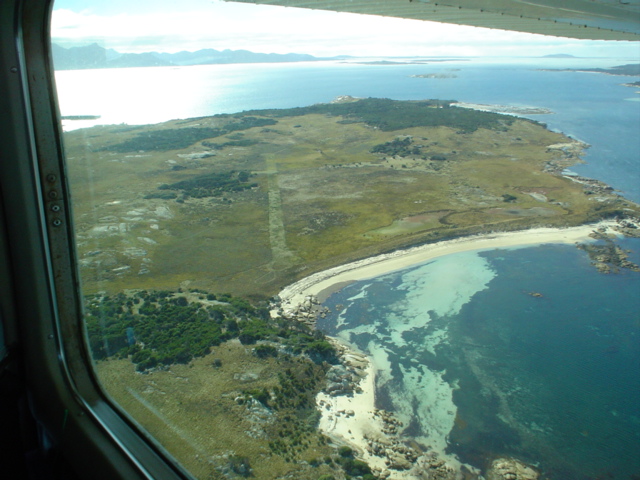
Some really beautiful scenery down here in Bass Straight.
|
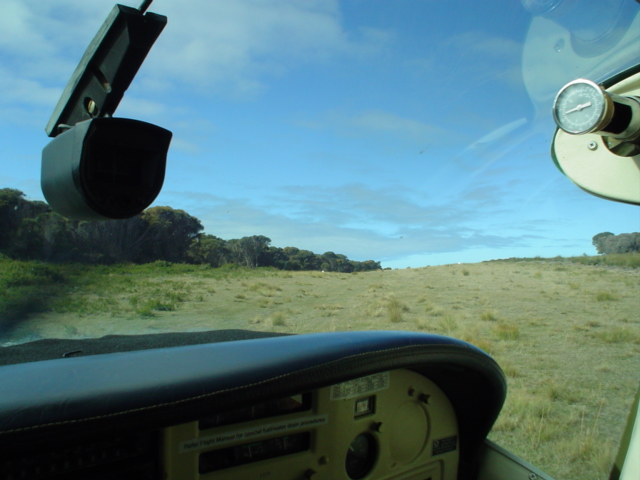
Cessna 206 VH- MRK Ready to roll at Clarke Island.
All of our flying here has to be under the VFR (visual flight rules) but you certainly do an apprenticeshipo flying across the Strait at 500 feet some days to run the mail, not a nice sight when the visibility gets down to next to nothing and you've got 5 metre seas lapping your undercarriage! On a good day however, there are plently of good islands to use as reference points for navigating by. 30-50 knot winds are common in the 40th parrallels so it's a good idea to flight plan well if your are heading into the winds, at upper levels you can quite often get a lot stronger winds than what the met guy has forecast (good if you're going with the wind) I've often had close to 200 knot groundspeeds in a 206! Here's a few good rules of thumb I fly by in our environment that have kept me alive.
1.ALWAYS keep your 'back door' open and never turn your back on the weather.
2.ALWAYS carry enough fuel to get where you planned to go and enough to get back from where you just came from. (fuel in your tanks is better than in a drum back on the ground.)
3.THE direct route you have planned may not necessarily be the route you can take.
4.ALWAYS set up for a 'go around' on finals, with a possibility of a landing. Especially so with strong windshears.
5.ALWAYS fly within your own limitations and increase your safety margins.
6.ALWAYS carry a tie down kit and a fishing rod!
Safe flying...Adam
|
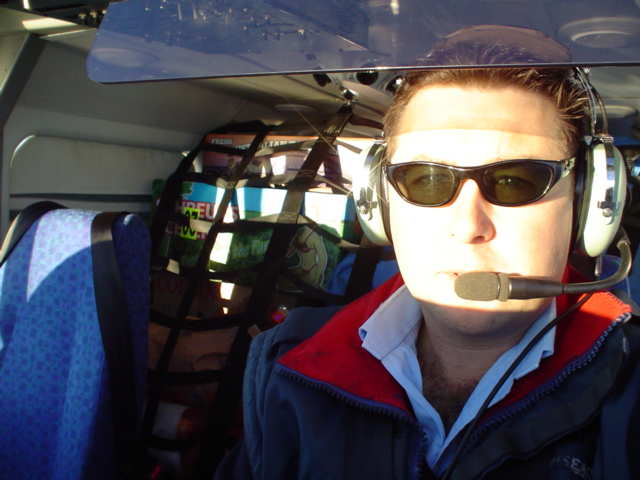
Packing frieght to the roof and hauling it across the islands was just another day at the office:)
|
|
|
